Editorial
Volume 3 Issue 1 - 2019
The Role of High-flow Nasal Cannula Oxygen Therapy in Adults with Acute Hypoxemic Respiratory Failure.
Pneumology, Allergy and Thoracic Surgery Department. Puerta del Mar University Hospital. Cádiz (Spain)
*Corresponding Author: PhD Aurelio Arnedillo, Pneumology, Allergy and Thoracic Surgery Department. Puerta del Mar University Hospital. Cádiz (Spain).
Receive: March 17, 2019; Published: March 26, 2019
Currently, there are different alternatives and various devices for oxygen therapy and ventilation that we can offer to patients with acute respiratory failure (ARF) according to their needs. Within this broad group, the High Flow Nasal Cannula Oxygen Therapy (HFNC) is a relatively recent alternative to conventional oxygen therapy and may even be an alternative to the use of non-invasive and even invasive mechanical ventilation [1,2].
This system allows to supply a gas flow of up to 60 l/min. The supplied gas is conditioned at the ideal temperature and humidity level (37◦C and 100% relative humidity) and also works with an oxygen and air mixer, which allows to apply a fraction of inspired oxygen (FiO2) from 21 to 100%. This mixture passes through the humidifier to a heated inspiratory circuit (to prevent condensation). Subsequently, this mixture is administered to the patient through nasal silicone cannulas. Thus, the main characteristic of the HFNC is that it allows the administration of a high humidified flow above the maximum inspiratory flow.
Until a few years ago, this type of oxygen therapy had been used mainly in neonates [3, 4], however, its use in adult patients has been increasing exponentially in recent years [5]. Regarding the importance of this oxygen therapy system, different studies have shown that the use of HFNC allows an improvement in the patient oxygenation due to diverse mechanisms, such as the decrease in the oxygen dilution administered with the air environment [6], then it can supply a flow high enough to reach the peak of patient's inspiratory demand; the decrease in dead space by supplying the flow directly to the nasopharynx, thus washing CO2, which prevents rebreathing and provides a reservoir of fresh gas [6,7]; the increase in circulating volume, due to the high flow that we can reach with the device, which may be equal to or greater than the patient's peak inspiratory demand, and the resistance of the upper airway can be minimized, decreasing respiratory work [6,8,9] thus increasing the amount of oxygenated air that reaches the lower airway and the generation of positive airway pressure (CPAP-like). Several studies have shown that with flows between 35 and 60 l/min, mean expiratory pressures are reached at the pharynx of 2-3 cmH2O with the mouth open and 5-7 cmH2O with the mouth closed [9,10]
There are also studies that corroborate the beneficial effects at the hemodynamic level [11], since the HFNC increase the lung impedance and, therefore, to an increase in tidal volumes. This fact is usually accompanied by a decrease in the respiratory rate without changes in arterial pressure of CO2 (PaCO2) [12], thus reducing the respiratory work added, in addition to the generation of a certain degree of intrathoracic positive pressure, could cause changes in the hemodynamic pattern of patients with ARF [13].
On the other hand, the use of HFNC improves the ability to perform efforts and increase the comfort of the patient due to the supply of gas with oxygen concentration, humidity and ideal temperature [14], and also due to the active humidification of the gas, improve mucociliary transport [15].
Although the use of the device is consolidated in clinical practice, the experience in adults is still limited in comparison to the experience in children, and even the clinical guidelines have not been positioned in terms of recommendations for use. However, there are several articles that provide sufficient evidence on the use of high-flow oxygen therapy in adult patients in different clinical situations. Within these indications are included acute respiratory failure [16, 17], we have seen in several studies a significant improvement in clinical and physiological parameters of these patients, it has also been analyzed how the use of HFNC could reduce the need for non-invasive mechanical ventilation (NIMV) and even invasive mechanical ventilation (IMV) in patients with ARF, with a failure rate of HFNC comparable to that of NIMV [12, 18]. On the other hand, it is important to know that there are a series of early predictors (in the first 12 hours) of failure of the HFNC, such as the persistence of tachypnea, thoracoabdominal uncoordination and the absence of improvement in hypoxemia [12].
Other indications are preoxygenation in tracheal intubation, especially in hypoxemic patients [19]; during the weaning of mechanical ventilation to prevent or treat post-extubation respiratory failure [20,21], during the performance of invasive procedures, such as fiberoptic bronchoscopy, transesophageal echocardiography or endoscopy, in patients with hypoxemia [22,23], patients with acute heart failure who present severe hypoxemia refractory to conventional oxygen therapy or patients with chronic heart failure whose success may lie both in oxygenation and in the improvement of the hemodynamic pattern [11,13], in postoperative patients of cardiac surgery, an area in which several studies show the benefits [9,24] and patients who are in end-of-life care recipients in whom NIV is not indicated, allows them to decrease the dyspnea sensation and an improvement of the hypoxemia, in addition, it allows them to communicate and even feed themselves [25,26].
In summary, the HFNC is an oxygen therapy option that, thanks to the adequate humidification and heating of the gas, allows to improve the oxygenation and the comfort of the patients. With the current evidence, HFNC oxygen therapy is an useful and attractive treatment modality in patients with severe hypoxemia triggered by various clinical entities, thanks to the effective improvement in oxygenation and decrease in respiratory work, being features and advantages that make the device is clearly booming at this time, especially in the field of intensive medicine and ventilation.
References
- Masclans J.R., et al. “Papel de la oxigenoterapia de alto flujo en la insuficiencia respiratoria aguda”. Medicina Intensiva 39 .8 (2015): 505-515.
- Helviz Y and Einav S. “A Systematic Review of the High-flow Nasal Cannula for Adult Patients”. Critical Care 22 (2018): 71.
- Wilkinson D., et al. “High flow nasal cannula for respiratory support in preterm infants”. The Cochrane Database of Systematic Reviews 5 (2016): CD006405.
- Beggs S., et al. “High-flow nasal cannula therapy for infants with bronchiolitis”. The Cochrane Database of Systematic Reviews 1(2014): CD009609.
- Lee JH., et al. “Use of high flow nasal cannula in critically ill infants, children, and adults: A critical review of the literature”. Intensive Care Medicine 39. 2 (2013): 247-257.
- Dysart K., et al. “Research in high flow therapy: Mechanisms of action”. Respiratory Medicine 103. 10(2009): 1400-1405.
- Ricard JD. “High flow nasal oxygen in acute respiratory failure”. Minerva Anestesiologica 78. 7 (2012): 836-841.
- Riera J., et al. “Effect of high-flow nasal cannula and body position on end-expiratory lung volume: A cohort study using electrical impedance tomography”. Respiratory Care 58. 4 (2013): 589-596.
- Corley A., et al. “Oxygen delivery through high-flow nasal cannulae increase end-expiratory lung volume and reduce respiratory rate in post- cardiac surgical patients”. British Journal of Anaesthesia 107. 6 (2011): 998-1004.
- Parke R., et al. “Nasal high-flow therapy delivers low level positive airway pressure”. British Journal of Anaesthesia 103. 6 (2009): 886-890.
- Roca O., et al. “Patients with New York Heart Association class III heart failure may benefit with high flow nasal cannula supportive therapy: High flow nasal cannula in heart failure”. Journal Critical Care 28. 5 (2013): 741-746.
- Sztrymf B., et al. “Beneficial effects of humidified high flow nasal oxygen in critical care patients: A prospective pilot study”. Intensive Care Medicine 37. 11 (2011): 1780-1786.
- Carratalá Perales JM., et al. “High-flow therapy via nasal cannula in acute heart failure”. Revista Española de Cardiología 64. 8 (2011): 723-725.
- Roca O., et al. “High-flow oxygen therapy in acute respiratory failure”. Respiratory Care 55. 4 (2010): 408-413.
- Sim MA., et al. “Performance of oxygen delivery devices when the breathing pattern of respiratory failure is simulated”. Anaesthesia 63. 9(2008): 938-940.
- Sotello D., et al. “High-flow nasal cannula oxygen in adult patients: A narrative review”. The American Journal of the Medical Sciences 349. 2(2015): 179- 185.
- Frat JP ., et al. “High-flow oxygen through nasal cannula in acute hypoxemic respiratory failure”. The New England Journal of Medicine 372 (2015): 2185-2196.
- Sztrymf B., et al. “Impact of high-flow nasal cannula oxygen therapy on intensive care unit patients with acute respiratory failure: A prospective observational study”. Journal of Critical Care 27. 3 (2012): 324.
- Miguel-Montanes R., et al. “Use of high-flow nasal cannula oxygen therapy to prevent desaturation during tracheal intubation of intensive care patients with mild-to-moderate hypoxemia”. Critical Care Medicine 43. 3(2015): 574-583.
- Maggiore SM., et al. “Nasal high-flow vs Venturi mask oxygen therapy after extubation: Effects on oxygenation, comfort and clinical outcome”. American Journal of Respiratory and Critical Care Medicine 190. 3(2014): 282- 288.
- Rittayamai N., et al. “High-flow nasal cannula versus conventional oxygen therapy after endotracheal extubation: A randomized crossover physiologic study”. Respiratory Care 59. 4(2014): 485-490.
- Lucangelo U., et al. “High-flow nasal interface improves oxygenation in patients undergoing bronchoscopy”. Critical Care Research and Practice 2012 (2012): 506382.
- Simon M,, et al. “High-flow nasal cannula oxygen versus non-invasive ventilation in patients with acute hypoxaemic respiratory failure undergoing flexible bronchoscopy - A prospective randomised trial”. Critical Care 18. 6 (2014): 712.
- Stéphan F., et al. “High-flow nasal oxygen vs noninvasive positive airway pressure in hypoxemic patients after cardiothoracic surgery: A randomized clinical trial”. JAMA 313. 23(2015): 2331-2339.
- Boyer A., et al. “Prognostic impact of high-flow nasal cannula oxygen supply in an ICU patient with pulmonary fibrosis complicated by acute respiratory failure”. Intensive Care Medicine 37. 3 (2011): 558-559.
- Mahler DA., et al. “American College of Chest Physicians consensus statement on the management of dyspnea in patients with advanced lung or heart disease”. Chest 137. 3 (2010): 674-691.
Citation:
Maria Perez-Morales and Aurelio Arnedillo. “The Role of High-flow Nasal Cannula Oxygen Therapy in Adults with Acute Hypoxemic Respiratory Failure.” Pulmonary Research and Respiratory Care 3.1 (2019): 179-181.
Copyright: © 2019 Maria Perez-Morales and Aurelio Arnedillo. This is an open-access article distributed under the terms of the Creative Commons Attribution License, which permits unrestricted use, distribution, and reproduction in any medium, provided the original author and source are credited.















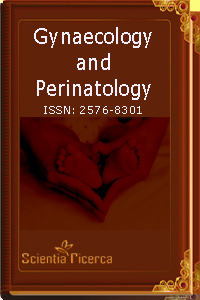
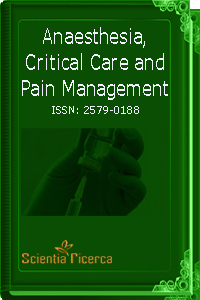


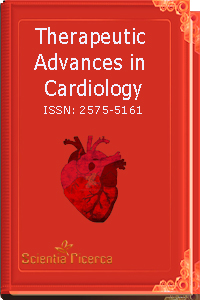




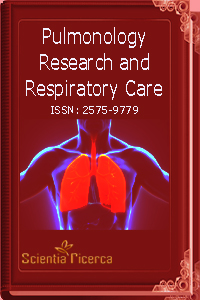



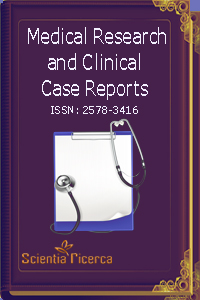
 Scientia Ricerca is licensed and content of this site is available under a Creative Commons Attribution 4.0 International License.
Scientia Ricerca is licensed and content of this site is available under a Creative Commons Attribution 4.0 International License.